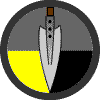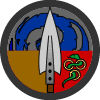|
The World of Teréth End - Supplements |
||||||||
|
"A song in your heart Inscribed on steps of Paldan Conservatory |
Book of Heraldry Heraldry began as an art by which persons on a battlefield could easily distinguish who stood among them, and who stood across the field against them. In the earliest days of heraldry such symbols and shields were basic and easy to read but as time advanced and the symbolism developed, most shields no longer adaquately serve that function. Acentran Heraldry The Kol dar Rallaun is an ancient repository of shields and heraldric symbols with indexes dating to the end of the Third Age (3/3711 ER). The first achievements were adopted from the Dwürden seals following the Pact of Dirimor, so that the Dwürden could tell their Uren allies from those that were not friendly. Dekàlan Heraldry Dekàlan heraldry is founded on the Acentran style. Before the Dekàlan Invasion of Rallaun in 4/2341 ER the "old style" was used. The Old Style was less developed than the Acentran heraldric code, consisting of simple icons that represented a person or family. The main limitation of the Old Style was that hundreds and thousands of icons needed to be memorized during large military movements, such as the First Acentran War which brought the Dekàlans to the island of Rallaun. Dekàlan generals of the time employed herald staffs to identify the shields of both friends and foes. Dekàlan Heraldry is traditionally depicted on a rondel. This feature more than any other divorces the shields of Dekàlas from those of the Acentran states which use the escutcheon. Three major elements are common to all Dekàlan shields, the Determiner, the Charge and the Border. The Determiner is some object that defines the reason why the person was given a shield in the first place. A thard's Determiner might have a sword (if that is his chosen weapon) while a scribe might have quill. The Charge is a symbol that designates the bearer a representative of a royal family, order, or temple. Many charges are adopted from the Old Style emlazons, adding an ancient quality to the shields. The Charge is very prevalent on a shield as it is the most distinguishable feature, other than the Determiner. The Charge and Determiner are encircled by the Border. The Border is a solid tinctured strip that is inscribed with Achievements of the bearer (i.e. noble orders, awards, recognitions). Border Achievements are written in the High Dekàlan script. Border Achievements are written clockwise from the center-left Border position [nine o'clock]. Traditionally, no Border Achievement may extend around more than one-quarter of the shield Border. Achievements scripted in gold are royal, silver are noble, bronze are religious, and the remainder are scripted in white.
The partitioning of a rondel may tell as much or more about the bearer than the accompanying badges. For instance, a horizontally divided shield [per fess] where the royal charge dominates (is located in the top-most partition) indicates a thard or other high representative of the charge. If the Determiner points upward across the charge, then that person is high ranking (perhaps a first thard), knighted for extroardinary action or purpose. Most Determiners point down on the shield, a distinction inherited from the tradition of how a thard or soldier may hold their weapons in the presence of their liege (and at attention). The shield of Jak of Candan (shown above right) is a good example of a basic present-day (7th Century DR) shield. The most notable element is the upright spearhead Determiner, indicative that the bearer is a high ranking thard, with a preference for spear (not a common weapon for northern thardram). [The Border contains the white words "Ordus Thardram Oth" (Order of Iron Knights) is interesting since members are usually inducted by a High Lord (royalty) which would mean that the words should (normally) be written in gold.] The bearer of this shield was inducted into the Holy Order in unorthodox fashion. The Charge of the shield is the Dekàlan D'agul of Oth, indicating that the bearer was knighted by the royalty of that city-state (this begs the question as to why the Achievement is not gold). Below the Charge are two Quarters, reserved to illuminate the thard's parentage. The sinister Badge (maternal) is the seal of the family Daralien (an old and influential family of Oth) which alone would give great prestige to the thard if not for the dexter Badge (paternal) which is left an empty brown Field. The brown field indicates that the thard's father was an unshielded peasant. No matter what deeds Jak of Candan might do over his life's course, this field will not be changed, and therefore his mother's indiscretions (having lain with a common man) are forever exposed and retold on the thard's shield.
|
Supplements Art |
||||||
|
Ref. PHB (Player's Handbook), © Wizards of the Coast  |
||||||||

